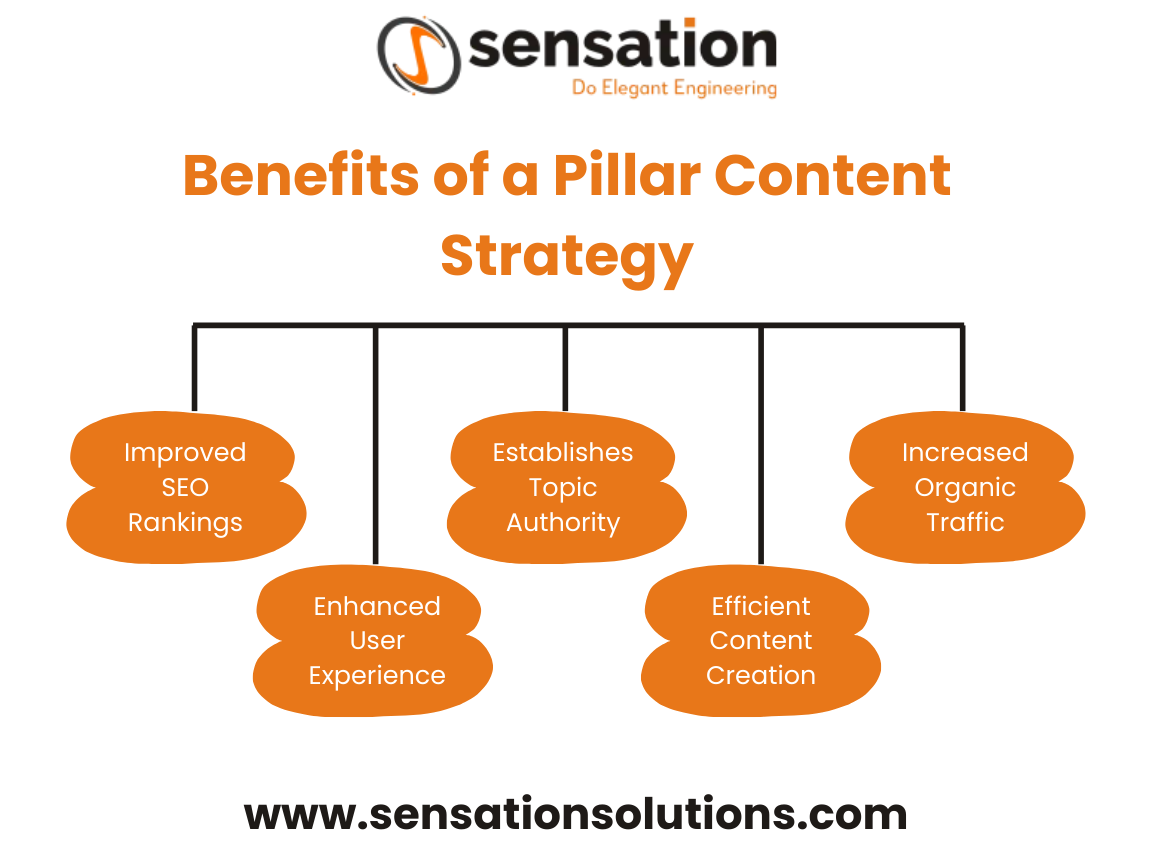Building Topic Authority with Pillar Content Strategies

Table of Contents
In the ever-evolving world of content marketing and SEO, establishing topic authority is crucial for standing out in a crowded digital landscape. One of the most effective ways to achieve this is by implementing a pillar content strategy. This approach helps you organize your content, boosts your search engine rankings, and builds trust with your audience. In this blog, we’ll explore a pillar content strategy, its benefits, and how you can use it to build topic authority.
Introduction to Pillar Content Strategy
A pillar content strategy is a method of organizing your website’s content around a central, comprehensive piece (the pillar page) that covers a broad topic in-depth. This pillar page is then supported by smaller, related pieces of content (cluster content) that dive into specific subtopics. Together, these form a content cluster, creating a web of interconnected information that signals to search engines your expertise on the subject.
This approach aligns perfectly with modern SEO content structure, as it helps search engines understand the context and relevance of your content. Focusing on topic authority, you position your brand as a go-to resource in your niche.

Benefits of a Pillar Content Strategy
1. Improved SEO Rankings: By creating a pillar and cluster model, you make it easier for search engines to crawl and index your content, improving your chances of ranking for multiple keywords. According to a study by HubSpot, websites with a well-structured content strategy see a 55% increase in organic traffic.
2. Enhanced User Experience: A well-structured content cluster guides users through a topic seamlessly, keeping them engaged and reducing bounce rates. Pages with internal links have been shown to reduce bounce rates by up to 40%.
3. Establishes Topic Authority: When you cover a topic comprehensively, you signal to users and search engines that you’re an expert in that area. Websites with potent topical authority are 3x more likely to rank on the first page of Google.
4. Efficient Content Creation: A pillar content strategy provides a clear framework for creating new content, saving time and effort. Companies that use content clusters report a 30% reduction in content creation time.
5. Increased Organic Traffic: By targeting a broad topic and its subtopics, you can attract a wider audience and drive more traffic to your site. Within six months, businesses using pillar content strategies have seen a 60% increase in organic traffic.
How to Build Topic Authority with Pillar Content Strategies
1. Choose a Core Topic
Start by identifying a broad topic that aligns with your audience’s interests and business goals. This will serve as the foundation for your pillar page. For example, if you’re in the fitness industry, your core topic could be “Home Workouts.”
2. Create a Comprehensive Pillar Page
Your pillar page should be an in-depth resource that covers the core topic comprehensively. Use a clear SEO content structure with headings, subheadings, and bullet points to make it easy to read. Include internal links to your cluster content to create a seamless user experience.
3. Develop Cluster Content
Cluster content consists of blog posts, videos, or infographics that explore specific subtopics related to your pillar page. For example, if your pillar page is about “Home Workouts,” your cluster content could include articles like “Best Yoga Poses for Beginners” or “10-Minute HIIT Workouts.”
4. Implement Keyword Clustering
Keyword clustering involves grouping related keywords and phrases to create a cohesive content strategy. For instance, if your core topic is “Home Workouts,” your keyword clusters might include “beginner home workouts,” “no-equipment workouts,” and “quick home exercises.” This helps you target a broader range of search queries.
5. Interlink Your Content
Internal linking is a critical component of the pillar and cluster model. Link your cluster content to the pillar page and vice versa to create a network of related information. This not only improves SEO but also enhances user navigation.
The Role of Topical Authority in SEO
Topical authority refers to your website’s perceived expertise on a specific subject. Search engines like Google prioritize websites that demonstrate topical authority because they provide valuable, reliable information to users.
By using a pillar content strategy, you can build topical authority by:
Covering a topic comprehensively.
Consistently publishing high-quality, related content.
Earning backlinks from reputable sources.
According to a BrightEdge study, 75% of marketers believe that creating content around a central topic is the most effective way to improve SEO performance.
Tools to Implement a Pillar Content Strategy
1. SEMrush: Use SEMrush to research and identify related keywords for your keyword clustering.
2. Ahrefs: This tool helps you analyze your competitors’ content and find gaps in your strategy.
3. Surfer SEO: Optimize your pillar page and cluster content with Surfer’s data-driven recommendations.
4. Google Analytics: Track the performance of your pillar page and cluster content to measure their impact on traffic and engagement.
New Updates for 2025
As we look ahead to 2025, content marketing and SEO are expected to become even more focused on user intent and topical authority. Here are some trends to watch:
1. AI-Driven Content Optimization: Tools like ChatGPT and Jasper will play a bigger role in creating and optimizing pillar content. By 2025, 40% of businesses are expected to use AI for content creation.
2. Voice Search Optimization: With the rise of voice search, structuring your content for conversational queries will be essential. By 2025, 75% of households are predicted to own a smart speaker.
3. E-E-A-T (Experience, Expertise, Authority, Trust): Google’s emphasis on E-E-A-T will make topic authority even more critical. Websites that fail to demonstrate expertise may see a 20% drop in rankings.
4.Content Clustering: Incorporating videos, infographics, and interactive content into your clusters will enhance engagement. Visual content is projected to account for 80% of all internet traffic by 2025.
Conclusion
Building topic authority with a pillar content strategy is a powerful way to elevate your content marketing efforts. By creating a comprehensive pillar page, developing cluster content, and implementing keyword clustering, you can establish yourself as an expert in your niche.
As the digital landscape evolves, staying ahead of trends like AI-driven optimization and voice search will be key to maintaining your competitive edge. Start implementing a pillar content strategy today, and watch your SEO and topic authority soar!
By focusing on these strategies and tools, you’ll improve your search rankings and provide real value to your audience, making Sensation Software Solutions a trusted resource in your industry . With the right approach, you can achieve topical authority and dominate your niche in 2025 and beyond.
How do I choose the right pillar topics for my website?
Identify high-value topics relevant to your industry, with substantial search volume and the potential to be broken into multiple subtopics. Keyword research and competitor analysis are essential steps.
What is the difference between pillar content and blog posts?
Pillar content is a long-form, evergreen resource that serves as the foundation for related cluster content, while blog posts typically cover specific subtopics in detail and link back to the pillar page.
How does pillar content help with Google’s E-E-A-T principles?
Well-structured pillar content showcases Experience, Expertise, Authority, and Trustworthiness (E-E-A-T) by offering valuable insights, credible sources, and an organized content structure that search engines favor.
Should pillar content be updated regularly?
Yes! Updating your pillar content every 6-12 months ensures accuracy, improves rankings, and maintains authority. Refresh statistics, add new insights, and optimize for evolving SEO trends.
How many supporting cluster articles should a pillar page have?
There’s no fixed number, but ideally, a pillar page should link to at least 5-10 cluster articles covering different aspects of the main topic. More high-quality, relevant content strengthens topic authority.







